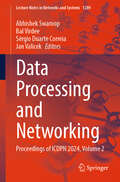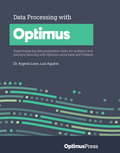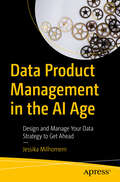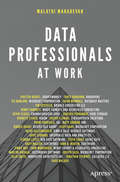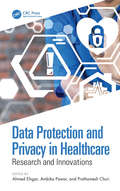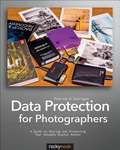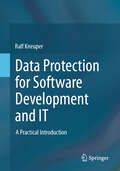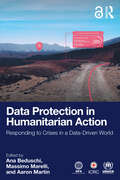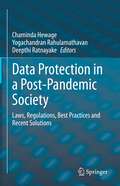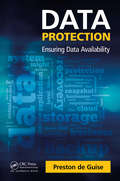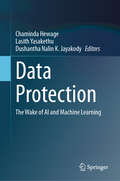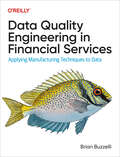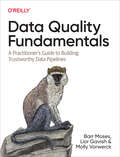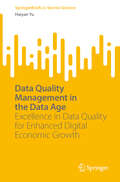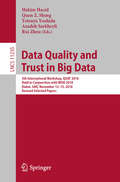- Table View
- List View
Data Processing Techniques and Applications for Cyber-Physical Systems (Advances in Intelligent Systems and Computing #1088)
by Neil Yen Chuanchao Huang Yu-Wei ChanThis book covers cutting-edge and advanced research on data processing techniques and applications for Cyber-Physical Systems. Gathering the proceedings of the International Conference on Data Processing Techniques and Applications for Cyber-Physical Systems (DPTA 2019), held in Shanghai, China on November 15–16, 2019, it examines a wide range of topics, including: distributed processing for sensor data in CPS networks; approximate reasoning and pattern recognition for CPS networks; data platforms for efficient integration with CPS networks; and data security and privacy in CPS networks. Outlining promising future research directions, the book offers a valuable resource for students, researchers and professionals alike, while also providing a useful reference guide for newcomers to the field.
Data Processing and Networking: Proceedings of ICDPN 2024, Volume 1 (Lecture Notes in Networks and Systems #1288)
by Abhishek Swaroop Sérgio Duarte Correia Bal Virdee Jan ValicekThis book includes selected papers presented at the International Conference on Data Processing and Networking (ICDPN 2024), organized by Institute of Technology and Business in České Budějovice, Near Prague, Czech Republic, during 25–26 October 2024. It covers up-to-date cutting-edge research on big data processing and analytics, data mining and machine learning, artificial intelligence and deep learning, wireless, mobile, and ad hoc networks, network security and privacy, internet of things (IOT) and sensor networks, data communication, and computer vision and image processing.
Data Processing and Networking: Proceedings of ICDPN 2024, Volume 2 (Lecture Notes in Networks and Systems #1289)
by Abhishek Swaroop Sérgio Duarte Correia Bal Virdee Jan ValicekThis book includes selected papers presented at the International Conference on Data-Processing and Networking (ICDPN 2024), organized by the Institute of Technology and Business in České Budějovice, Near Prague, Czech Republic, during October 25–26, 2024. It covers up-to-date cutting-edge research on big data-processing and analytics, data mining and machine learning, artificial intelligence and deep learning, wireless, mobile, and ad hoc networks, network security and privacy, Internet of things (IoT) and sensor networks, data communication, and computer vision and image processing.
Data Processing with Optimus: Supercharge big data preparation tasks for analytics and machine learning with Optimus using Dask and PySpark
by Dr. Argenis Leon Luis AguirreWritten by the core Optimus team, this comprehensive guide will help you to understand how Optimus improves the whole data processing landscapeKey FeaturesLoad, merge, and save small and big data efficiently with OptimusLearn Optimus functions for data analytics, feature engineering, machine learning, cross-validation, and NLPDiscover how Optimus improves other data frame technologies and helps you speed up your data processing tasksBook DescriptionOptimus is a Python library that works as a unified API for data cleaning, processing, and merging data. It can be used for handling small and big data on your local laptop or on remote clusters using CPUs or GPUs.The book begins by covering the internals of Optimus and how it works in tandem with the existing technologies to serve your data processing needs. You'll then learn how to use Optimus for loading and saving data from text data formats such as CSV and JSON files, exploring binary files such as Excel, and for columnar data processing with Parquet, Avro, and OCR. Next, you'll get to grips with the profiler and its data types - a unique feature of Optimus Dataframe that assists with data quality. You'll see how to use the plots available in Optimus such as histogram, frequency charts, and scatter and box plots, and understand how Optimus lets you connect to libraries such as Plotly and Altair. You'll also delve into advanced applications such as feature engineering, machine learning, cross-validation, and natural language processing functions and explore the advancements in Optimus. Finally, you'll learn how to create data cleaning and transformation functions and add a hypothetical new data processing engine with Optimus.By the end of this book, you'll be able to improve your data science workflow with Optimus easily.What you will learnUse over 100 data processing functions over columns and other string-like valuesReshape and pivot data to get the output in the required formatFind out how to plot histograms, frequency charts, scatter plots, box plots, and moreConnect Optimus with popular Python visualization libraries such as Plotly and AltairApply string clustering techniques to normalize stringsDiscover functions to explore, fix, and remove poor quality dataUse advanced techniques to remove outliers from your dataAdd engines and custom functions to clean, process, and merge dataWho this book is forThis book is for Python developers who want to explore, transform, and prepare big data for machine learning, analytics, and reporting using Optimus, a unified API to work with Pandas, Dask, cuDF, Dask-cuDF, Vaex, and Spark. Although not necessary, beginner-level knowledge of Python will be helpful. Basic knowledge of the CLI is required to install Optimus and its requirements. For using GPU technologies, you'll need an NVIDIA graphics card compatible with NVIDIA's RAPIDS library, which is compatible with Windows 10 and Linux.
Data Product Management in the AI Age: Design and Manage Your Data Strategy to Get Ahead
by Jessika Milhomem&“An outstanding companion for any data professional seeking to deepen their expertise and grow in the field of Data Product Management.&” (Eduardo Juremeira, Data Engineering Manager, Adyen) &“This book is a valuable resource for data professionals, offering clear concepts and practical tools.&” (Luis Oliveira, Analytics Engineering Tech Manager, Nubank) A practical guide to mastering data product management—bridging strategy, architecture, and execution for the AI era. We have firmly entered the age of artificial intelligence (AI). Data, the backbone of this technology, is more crucial than ever. If the algorithm is the brain, data is the content that feeds it. This book argues that to succeed in this era, organizations should adopt a holistic approach to data—one that uses product management principles to inform how data is sourced, designed, managed, maintained, optimized, and leveraged. This book is divided into two sections, moving from fundamentals to practical applications. In the first part, you&’ll learn about the concepts that underlie product theory, the data architecture journey, and the essential knowledge needed to manage data products. The second part focuses on putting everything into practice, with particular attention to designing solutions, ongoing maintenance, and optimization. Additionally, the book introduces the Golden Data Platform and the Data Product Management Canvas, important tools and frameworks coined by author Jessika Milhomem. These resources will help you begin transforming your organization&’s data strategy, empowering you to stay ahead of the competition and thrive in the AI age. What You Will Learn Explore the evolution of data architecture and strategies Understand the fundamentals of data product management Differentiate between Data Product and Data as a Product Know what the Golden Data Platform is and how to use it Utilize the Data Product Management Canvas effectively Reorient your data strategy with product management principles Examine the concepts of products and data architecture evolution in relation to leadership Evaluate how to solve data architecture without bias by technology Design and implement Data as a Product and Data Products through a project Maintain and enhance Data Products once launched Who </stron
Data Professionals at Work
by Malathi MahadevanEnjoy reading interviews with more than two dozen data professionals to see a picture of what it’s like to work in the industry managing and analyzing data, helping you to know what it takes to move from your current expertise into one of the fastest growing areas of technology today. Data is the hottest word of the century, and data professionals are in high demand. You may already be a data professional such as a database administrator or business intelligence analyst. Or you may be one of the many people who want to work as a data professional, and are curious how to get there. Either way, this collection helps you understand how data professionals work, what makes them successful, and what they do to keep up.You’ll find interviews in this book with database administrators, database programmers, data architects, business intelligence professionals, and analytics professionals. Interviewees work across industry sectors ranging from healthcare and banking to finance and transportation and beyond. Each chapter illuminates a successful professional at the top of their game, who shares what helped them get to the top, and what skills and attitudes combine to make them successful in their respective fields.Interviewees in the book include: Mindy Curnutt, Julie Smith, Kenneth Fisher, Andy Leonard, Jes Borland, Kevin Feasel, Ginger Grant, Vicky Harp, Kendra Little, Jason Brimhall, Tim Costello, Andy Mallon, Steph Locke, Jonathan Stewart, Joseph Sack, John Q. Martin, John Morehouse, Kathi Kellenberger, Argenis Fernandez, Kirsten Benzel, Tracy Boggiano, Dave Walden, Matt Gordon, Jimmy May, Drew Furgiuele, Marlon Ribunal, and Joseph Fleming. All of them have been successful in their careers, and share their perspectives on working and succeeding in the field as data and database professionals. What You'll LearnStand out as an outstanding professional in your area of data work by developing the right set of skills and attitudes that lead to successAvoid common mistakes and pitfalls, and recover from operational failures and bad technology decisionsUnderstand current trends and best practices, and stay out in front as the field evolvesBreak into working with data through database administration, business intelligence, or any of the other career paths represented in this bookManage stress and develop a healthy work-life balance no matter which career path you decide uponChoose a suitable path for yourself from among the different career paths in working with dataWho This Book Is ForDatabase administrators and developers, database and business intelligence architects, consultants, and analytic professionals, as well as those intent on moving into one of those career paths. Aspiring data professionals and those in related technical fields who want to make a move toward managing or analyzing data on a full-time basis will find the book useful. Existing data professionals who want to be outstanding and successful at what they do will also appreciate the book's advice and guidance.
Data Protection Compliance in the UK
by Rosemary Jay Jenna ClarkeOrganisations now face much stiffer penalties for breaching the Data Protection Act, which makes this pocket guide more valuable than ever!Your company holds personal information about your customers in electronic form. Almost certainly, you will also keep records on your staff in your computer system. In the digital age, managing personal information has become a key organisational challenge. For legal reasons, everyone has to understand the proper way to handle this personal data. ComplianceYour business needs to operate in compliance with the Data Protection Act. This means your company has to take the right steps towards secure management of personal digital information. Under the Data Protection Act, some faults are treated as criminal offences. Where failure to comply is the fault of a manager, the manager can be prosecuted along with the company. A tougher regulatory environmentKnowingly, or recklessly, obtaining or disclosing personal data is an offence under Section 55 of the Data Protection Act. In 2009, the Coroners and Justice Act amended the DPA to give the Information Commissioner the power to carry out compulsory assessments of government departments. This year, the government has further tightened the enforcement regime for the DPA. On 6 April 2010, tougher penalties came into effect, including custodial sentences for deliberate or careless disclosure of personal data. Deliberate, or reckless, disclosure of personal data by your staff will also put you in the firing line as their employer. The Information Commissioner''s Office has acquired new powers to fine companies up to £500,000 for serious contraventions of the Data Protection Act. This pocket guide gives you a clear description of the Data Protection Act, outlining its terms and explaining its requirements. It is essential reading if you have a responsibility for the security of personal data, especially if you are a director, a manager or an IT professional. The pocket guide includes handy good practice tips for staff. The easy-to-follow checklist tells you the practical steps you should be taking in order to comply with the Data Protection Act. Benefits to business include: * Avoid expensive litigation Failure to comply with the Data Protection Act can lead to a heavy fine, as well as complaints and reputational damage. Use this book to help your company avoid embarrassing disputes and costly litigation. * Avoid illegal monitoring and interception There are good reasons why you might want to listen to customer calls (monitoring) or to record them (interception). Use this book to ensure that you monitor and intercept calls and e-mails in a way that is legal. * Understand transfer of data overseas To improve customer service or streamline operations, your company may wish to transfer personal digital information overseas (offshoring). This book advises you on when it is legal to do this. It offers you guidance on transfer of data outside the European Economic Area, and on the US-EU Safe Harbor Agreement. * Handle electronic marketing properly You need to understand the special rules that concern e-mail marketing. Use this book to make sure that your online marketing campaigns are being run in a way that is legal. Data Protection Compliance in the UK has been published as an inexpensive and easily read introduction for any employee required to support compliance with the DPA. It: * Outlines UK and EU data protection regulations; * Describes the rights of individuals; * Explains the security obligations of organizations; * Addresses topics including o IT monitoring and interception, o enforcement provisions and o penalties for non-compliance. Reputational risksA survey conducted by IT Governance has shown that only around half of those employees who handle personal information have been trained in their Data Protection Act responsibilities. And yet failure to comply with the Data Protection Act can have damaging consequences. The scandal at T-Mobile has highlighted the need for businesses to tighten up their data securi...
Data Protection Law: A Comparative Analysis of Asia-Pacific and European Approaches
by Robert Walters Leon Trakman Bruno ZellerThis book provides a comparison and practical guide for academics, students, and the business community of the current data protection laws in selected Asia Pacific countries (Australia, India, Indonesia, Japan Malaysia, Singapore, Thailand) and the European Union.The book shows how over the past three decades the range of economic, political, and social activities that have moved to the internet has increased significantly. This technological transformation has resulted in the collection of personal data, its use and storage across international boundaries at a rate that governments have been unable to keep pace. The book highlights challenges and potential solutions related to data protection issues arising from cross-border problems in which personal data is being considered as intellectual property, within transnational contracts and in anti-trust law. The book also discusses the emerging challenges in protecting personal data and promoting cyber security. The book provides a deeper understanding of the legal risks and frameworks associated with data protection law for local, regional and global academics, students, businesses, industries, legal profession and individuals.
Data Protection and Privacy in Healthcare: Research and Innovations
by Ahmed Elngar, Ambika Pawar, and Prathamesh ChuriThe Healthcare industry is one of the largest and rapidly developing industries. Over the last few years, healthcare management is changing from disease centered to patient centered. While on one side the analysis of healthcare data plays an important role in healthcare management, but on the other side the privacy of a patient’s record must be of equal concern. This book uses a research-oriented approach and focuses on privacy-based healthcare tools and technologies. It offers details on privacy laws with real-life case studies and examples, and addresses privacy issues in newer technologies such as Cloud, Big Data, and IoT. It discusses the e-health system and preserving its privacy, and the use of wearable technologies for patient monitoring, data streaming and sharing, and use of data analysis to provide various health services. This book is written for research scholars, academicians working in healthcare and data privacy domains, as well as researchers involved with healthcare law, and those working at facilities in security and privacy domains. Students and industry professionals, as well as medical practitioners might also find this book of interest.
Data Protection and Privacy: (Law, Governance and Technology Series #36)
by Paul De Hert Serge Gutwirth Ronald Leenes Rosamunde Van BrakelThis book features peer reviewed contributions from across the disciplines on themes relating to protection of data and to privacy protection. The authors explore fundamental and legal questions, investigate case studies and consider concepts and tools such as privacy by design, the risks of surveillance and fostering trust. Readers may trace both technological and legal evolution as chapters examine current developments in ICT such as cloud computing and the Internet of Things. Written during the process of the fundamental revision of revision of EU data protection law (the 1995 Data Protection Directive), this volume is highly topical. Since the European Parliament has adopted the General Data Protection Regulation (Regulation 2016/679), which will apply from 25 May 2018, there are many details to be sorted out. This volume identifies and exemplifies key, contemporary issues. From fundamental rights and offline alternatives, through transparency requirements to health data breaches, the reader is provided with a rich and detailed picture, including some daring approaches to privacy and data protection. The book will inform and inspire all stakeholders. Researchers with an interest in the philosophy of law and philosophy of technology, in computers and society, and in European and International law will all find something of value in this stimulating and engaging work.
Data Protection for Photographers
by Patrick H. CorriganAll photographers, both amateur and professional, are faced with the important issues of data protection and storage. Without knowledge of the options, tools, and procedures for safe and effective image protection and storage, photographers run the serious risk of losing their image files. This book offers critical information about the best hardware, software, procedures, and practices for capturing, storing, and preserving images and other data. This book explains current data protection and storage technologies in everyday terms. It describes effective procedures for protecting data, from capture to backup and archiving. Descriptions of specific products applicable to Windows, MacOS, and Linux systems are provided.
Data Protection for Software Development and IT: A Practical Introduction
by Ralf KneuperThis book introduces data protection, i.e. the protection of individuals from misuse of their personal data. It provides a special focus on the direct impact on software development, e.g. in the form of functional requirements for software systems resulting from data protection. Chapter 1 provides an initial overview of the basic concepts of data protection and its legal foundations. Chapter 2 then delves deeper into the European General Data Protection Regulation (GDPR), covering in particular its basic concepts, terminology and requirements. Next, the specific implementation and interpretation of GDPR requirements in software and IT are dealt with, starting in chapter 3 with the principles of data protection defined in GDPR and the rights of data subjects in chapter 4. Chapter 5 discusses data transfer between organizations, including the relevant constellations (e.g. through various service providers), the legal framework and its practical implementation. Subsequently, chapter 6 changes the view from individual regulations and their implementation to technical and organizational design of data protection, including its embedding in the software life cycle, while chapter 7 provides an overview of information security and its aspects relevant to data protection. Eventually, chapter 8 deals with data protection for organizations as they are data subjects themselves. The appendices contain the most important excerpts from the Charter of Fundamental Rights of the EU and GDPR in this context, a collection of links to relevant laws and supervisory authorities, as well as a glossary of the most important terms used. The book’s target groups include software developers, IT consultants, requirements analysts, IT operations personnel and project managers in IT projects, but also data protection managers and data protection officers in the context of software development and IT.
Data Protection in Humanitarian Action: Responding to Crises in a Data-Driven World
by Ana Beduschi, Massimo Marelli, and Aaron MartinThis book is the product of a collaboration between the data protection offices of the ICRC and UNHCR, alongside the Global Privacy Assembly, to reflect on a decade of progress in data protection in humanitarian contexts. Through practitioner perspectives, empirical research, and conceptual reflections, it examines how data protection underpins trust, accountability, and respect for affected populations, serving as a crucial enabler for ethical and effective humanitarian action in the digital age.The volume explores critical topics including digital transformation, operational complexities such as those linked to data breaches and data sharing, regulatory developments and international cooperation, legal frameworks and capacity-building. At the same time, it looks ahead, addressing the challenges and opportunities posed by emerging technologies and considering how the humanitarian sector may anticipate and prepare for them.This book is intended for policymakers, practitioners, authorities, academics, and other experts working in data protection, international organisations, and humanitarian action and adjacent fields. It offers a compass to help navigate complex operational and legal challenges in an increasingly digital and data-driven landscape. By positioning data protection as a foundational element of humanitarian action, the book provides timely, forward-looking insights into the sector’s preparedness for technological and regulatory change, with the aim of helping those most in need.The Open Access version of this book, available at www.taylorfrancis.com, has been made available under a Creative Commons Attribution-Non Commercial-No Derivatives (CC-BY-NC-ND) 4.0 International license.
Data Protection in a Post-Pandemic Society: Laws, Regulations, Best Practices and Recent Solutions
by Chaminda Hewage Yogachandran Rahulamathavan Deepthi RatnayakeThis book offers the latest research results and predictions in data protection with a special focus on post-pandemic society. This book also includes various case studies and applications on data protection. It includes the Internet of Things (IoT), smart cities, federated learning, Metaverse, cryptography and cybersecurity. Data protection has burst onto the computer security scene due to the increased interest in securing personal data. Data protection is a key aspect of information security where personal and business data need to be protected from unauthorized access and modification. The stolen personal information has been used for many purposes such as ransom, bullying and identity theft. Due to the wider usage of the Internet and social media applications, people make themselves vulnerable by sharing personal data. This book discusses the challenges associated with personal data protection prior, during and post COVID-19 pandemic. Some of these challenges are caused by the technological advancements (e.g. Artificial Intelligence (AI)/Machine Learning (ML) and ChatGPT). In order to preserve the privacy of the data involved, there are novel techniques such as zero knowledge proof, fully homomorphic encryption, multi-party computations are being deployed. The tension between data privacy and data utility drive innovation in this area where numerous start-ups around the world have started receiving funding from government agencies and venture capitalists. This fuels the adoption of privacy-preserving data computation techniques in real application and the field is rapidly evolving. Researchers and students studying/working in data protection and related security fields will find this book useful as a reference.
Data Protection in the Internet (Ius Comparatum - Global Studies in Comparative Law #38)
by Dário Moura Vicente Sofia de Vasconcelos CasimiroThis book identifies and explains the different national approaches to data protection – the legal regulation of the collection, storage, transmission and use of information concerning identified or identifiable individuals – and determines the extent to which they could be harmonised in the foreseeable future. In recent years, data protection has become a major concern in many countries, as well as at supranational and international levels. In fact, the emergence of computing technologies that allow lower-cost processing of increasing amounts of information, associated with the advent and exponential use of the Internet and other communication networks and the widespread liberalization of the trans-border flow of information have enabled the large-scale collection and processing of personal data, not only for scientific or commercial uses, but also for political uses. A growing number of governmental and private organizations now possess and use data processing in order to determine, predict and influence individual behavior in all fields of human activity. This inevitably entails new risks, from the perspective of individual privacy, but also other fundamental rights, such as the right not to be discriminated against, fair competition between commercial enterprises and the proper functioning of democratic institutions. These phenomena have not been ignored from a legal point of view: at the national, supranational and international levels, an increasing number of regulatory instruments – including the European Union’s General Data Protection Regulation applicable as of 25 May 2018 – have been adopted with the purpose of preventing personal data misuse. Nevertheless, distinct national approaches still prevail in this domain, notably those that separate the comprehensive and detailed protective rules adopted in Europe since the 1995 Directive on the processing of personal data from the more fragmented and liberal attitude of American courts and legislators in this respect. In a globalized world, in which personal data can instantly circulate and be used simultaneously in communications networks that are ubiquitous by nature, these different national and regional approaches are a major source of legal conflict.
Data Protection on the Move: Current Developments in ICT and Privacy/Data Protection (Law, Governance and Technology Series #24)
by Serge Gutwirth Ronald Leenes Paul HertThis volume brings together papers that offer methodologies, conceptual analyses, highlight issues, propose solutions, and discuss practices regarding privacy and data protection. It is one of the results of the eight annual International Conference on Computers, Privacy, and Data Protection, CPDP 2015, held in Brussels in January 2015. The book explores core concepts, rights and values in (upcoming) data protection regulation and their (in)adequacy in view of developments such as Big and Open Data, including the right to be forgotten, metadata, and anonymity. It discusses privacy promoting methods and tools such as a formal systems modeling methodology, privacy by design in various forms (robotics, anonymous payment), the opportunities and burdens of privacy self management, the differentiating role privacy can play in innovation. The book also discusses EU policies with respect to Big and Open Data and provides advice to policy makers regarding these topics. Also attention is being paid to regulation and its effects, for instance in case of the so-called 'EU-cookie law' and groundbreaking cases, such as Europe v. Facebook. This interdisciplinary book was written during what may turn out to be the final stages of the process of the fundamental revision of the current EU data protection law by the Data Protection Package proposed by the European Commission. It discusses open issues and daring and prospective approaches. It will serve as an insightful resource for readers with an interest in privacy and data protection.
Data Protection: Ensuring Data Availability
by Preston de GuiseThis is the fundamental truth about data protection: backup is dead. Or rather, backup and recovery, as a standalone topic, no longer has relevance in IT. As a standalone topic, it’s been killed off by seemingly exponential growth in storage and data, by the cloud, and by virtualization. So what is data protection? This book takes a holistic, business-based approach to data protection. It explains how data protection is a mix of proactive and reactive planning, technology and activities that allow for data continuity. It shows how truly effective data protection comes from a holistic approach considering the entire data lifecycle and all required SLAs. Data protection is neither RAID nor is it continuous availability, replication, snapshots or backups—it is all of them, combined in a considered and measured approach to suit the criticality of the data and meet all the requirements of the business. The book also discusses how businesses seeking to creatively leverage their IT investments and to drive through cost optimization are increasingly looking at data protection as a mechanism to achieve those goals. In addition to being a type of insurance policy, data protection is becoming an enabler for new processes around data movement and data processing. This book arms readers with information critical for making decisions on how data can be protected against loss in the cloud, on-premises, or in a mix of the two. It explains the changing face of recovery in a highly virtualized data center and techniques for dealing with big data. Moreover, it presents a model for where data recovery processes can be integrated with IT governance and management in order to achieve the right focus on recoverability across the business.
Data Protection: Ensuring Data Availability
by Preston de GuiseThe second edition of Data Protection goes beyond the traditional topics including deduplication, continuous availability, snapshots, replication, backup, and recovery, and explores such additional considerations as legal, privacy, and ethical issues. A new model is presented for understanding and planning the various aspects of data protection, which is essential to developing holistic strategies. The second edition also addresses the cloud and the growing adoption of software and function as a service, as well as effectively planning over the lifespan of a workload: what the best mix of traditional and cloud native data protection services might be. Virtualization continues to present new challenges to data protection, and the impact of containerization is examined. The book takes a holistic, business-based approach to data protection. It explains how data protection is a mix of proactive and reactive planning, technology, and activities that allow for data continuity. There are three essential activities that refer to themselves as data protection; while they all overlap in terms of scope and function, each operates as a reasonably self-contained field with its own specialists and domain nomenclature. These three activities are: • Data protection as a storage and recovery activity • Data protection as a security activity • Data protection as a privacy activity These activities are covered in detail, with a focus on how organizations can use them to leverage their IT investments and optimize costs. The book also explains how data protection is becoming an enabler for new processes around data movement and data processing. This book arms readers with information critical for making decisions on how data can be protected against loss in the cloud, on premises, or in a mix of the two. It explains the changing face of recovery in a highly virtualized datacenter and techniques for dealing with big data. Moreover, it presents a model for where data recovery processes can be integrated with IT governance and management in order to achieve the right focus on recoverability across the business. About the Author Preston de Guise has been working with data recovery products for his entire career—designing, implementing, and supporting solutions for governments, universities, and businesses ranging from SMEs to Fortune 500 companies. This broad exposure to industry verticals and business sizes has enabled Preston to understand not only the technical requirements of data protection and recovery, but the management and procedural aspects too.
Data Protection: Governance, Risk Management, and Compliance
by David G. HillFailure to appreciate the full dimensions of data protection can lead to poor data protection management, costly resource allocation issues, and exposure to unnecessary risks. Data Protection: Governance, Risk Management, and Compliance explains how to gain a handle on the vital aspects of data protection.The author begins by building the foundatio
Data Protection: The Wake of AI and Machine Learning
by Dushantha Nalin K. Jayakody Chaminda Hewage Lasith YasakethuThis book provides a thorough and unique overview of the challenges, opportunities and solutions related with data protection in the age of AI and ML technologies. It investigates the interface of data protection and new technologies, emphasising the growing need to safeguard personal and confidential data from unauthorised access and change. The authors emphasize the crucial need of strong data protection regulations, focusing on the consequences of AI and ML breakthroughs for privacy and individual rights. This book emphasizes the multifarious aspect of data protection, which goes beyond technological solutions to include ethical, legislative and societal factors. This book explores into the complexity of data protection in the age of AI and ML. It investigates how massive volumes of personal and sensitive data are utilized to train and develop AI models, demanding novel privacy-preserving strategies such as anonymization, differential privacy and federated learning. The duties and responsibilities of engineers, policy makers and ethicists in minimizing algorithmic bias and ensuring ethical AI use are carefully defined. Key developments, such as the influence of the European Union's General Data Protection Regulation (GDPR) and the EU AI Act on data protection procedures, are reviewed critically. This investigation focusses not only on the tactics used, but also on the problems and successes in creating a secure and ethical AI ecosystem. This book provides a comprehensive overview of the efforts to integrate data protection into AI innovation, including valuable perspectives on the effectiveness of these measures and the ongoing adjustments required to address the fluid nature of privacy concerns. This book is a helpful resource for upper-undergraduate and graduate computer science students, as well as others interested in cybersecurity and data protection. Researchers in AI, ML, and data privacy as well as data protection officers, politicians, lawmakers and decision-makers will find this book useful as a reference.
Data Push Apps with HTML5 SSE: Pragmatic Solutions for Real-World Clients
by Darren CookMake sure your website or web application users get content updates right now with minimal latency. This concise guide shows you how to push new data from the server to clients with HTML5 Server-Sent Events (SSE), an exceptional technology that doesn’t require constant polling or user interaction. You’ll learn how to build a real-world SSE application from start to finish that solves a demanding domain problem.You’ll also discover how to increase that application’s desktop and mobile browser support from 60% to 99%, using different fallback solutions. If you’re familiar with HTML, HTTP, and basic JavaScript, you’re ready to get started.Determine whether SSE, WebSockets, or data pull is best for your organizationDevelop a working SSE application complete with backend and frontend solutionsAddress error handling, system recovery, and other issues to make the application production-qualityExplore two fallback solutions for browsers that don’t support SSETackle security issues, including authorization and "disallowed origin"Develop realistic, repeatable data that’s useful in test-driven SSE designLearn SSE protocol elements not covered in the example application
Data Quality Engineering in Financial Services: Applying Manufacturing Techniques to Data
by Brian BuzzelliData quality will either make you or break you in the financial services industry. Missing prices, wrong market values, trading violations, client performance restatements, and incorrect regulatory filings can all lead to harsh penalties, lost clients, and financial disaster. This practical guide provides data analysts, data scientists, and data practitioners in financial services firms with the framework to apply manufacturing principles to financial data management, understand data dimensions, and engineer precise data quality tolerances at the datum level and integrate them into your data processing pipelines.You'll get invaluable advice on how to:Evaluate data dimensions and how they apply to different data types and use casesDetermine data quality tolerances for your data quality specificationChoose the points along the data processing pipeline where data quality should be assessed and measuredApply tailored data governance frameworks within a business or technical function or across an organizationPrecisely align data with applications and data processing pipelinesAnd more
Data Quality Fundamentals: A Practitioner's Guide to Building Trustworthy Data Pipelines
by Barr Moses Lior Gavish Molly VorwerckDo your product dashboards look funky? Are your quarterly reports stale? Is the data set you're using broken or just plain wrong? These problems affect almost every team, yet they're usually addressed on an ad hoc basis and in a reactive manner. If you answered yes to these questions, this book is for you. Many data engineering teams today face the "good pipelines, bad data" problem. It doesn't matter how advanced your data infrastructure is if the data you're piping is bad. In this book, Barr Moses, Lior Gavish, and Molly Vorwerck, from the data observability company Monte Carlo, explain how to tackle data quality and trust at scale by leveraging best practices and technologies used by some of the world's most innovative companies. Build more trustworthy and reliable data pipelinesWrite scripts to make data checks and identify broken pipelines with data observabilityLearn how to set and maintain data SLAs, SLIs, and SLOsDevelop and lead data quality initiatives at your companyLearn how to treat data services and systems with the diligence of production softwareAutomate data lineage graphs across your data ecosystemBuild anomaly detectors for your critical data assets
Data Quality Management in the Data Age: Excellence in Data Quality for Enhanced Digital Economic Growth (SpringerBriefs in Service Science)
by Haiyan YuThis book addresses data quality management for data markets, including foundational quality issues in modern data science. By clarifying the concept of data quality, its impact on real-world applications, and the challenges stemming from poor data quality, it will equip data scientists and engineers with advanced skills in data quality management, with a particular focus on applications within data markets. This will help them create an environment that encourages potential data sellers with high-quality data to join the market, ultimately leading to an improvement in overall data quality. High-quality data, as a novel factor of production, has assumed a pivotal role in driving digital economic development. The acquisition of such data is particularly important for contemporary decision-making models. Data markets facilitate the procurement of high-quality data and thereby enhance the data supply. Consequently, potential data sellers with high-quality data are incentivized to enter the market, an aspect that is particularly relevant in data-scarce domains such as personalized medicine and services. Data scientists have a pivotal role to play in both the intellectual vitality and the practical utility of high-quality data. Moreover, data quality control presents opportunities for data scientists to engage with less structured or ambiguous problems. The book will foster fruitful discussions on the contributions that various scientists and engineers can make to data quality and the further evolution of data markets.
Data Quality and Trust in Big Data: 5th International Workshop, QUAT 2018, Held in Conjunction with WISE 2018, Dubai, UAE, November 12–15, 2018, Revised Selected Papers (Lecture Notes in Computer Science #11235)
by Quan Z. Sheng Rui Zhou Hakim Hacid Tetsuya Yoshida Azadeh SarkheyliThis book constitutes revised selected papers from the International Workshop on Data Quality and Trust in Big Data, QUAT 2018, which was held in conjunction with the International Conference on Web Information Systems Engineering, WISE 2018, in Dubai, UAE, in November 2018. The 9 papers presented in this volume were carefully reviewed and selected from 15 submissions. They deal with novel ideas and solutions related to the problems of exploring, assessing, monitoring, improving, and maintaining the quality of data and trust for Big Data.


